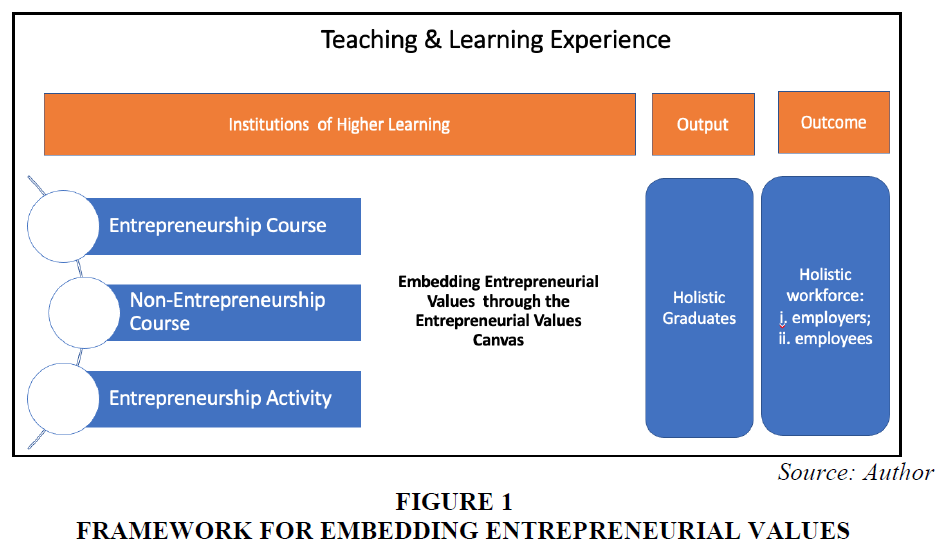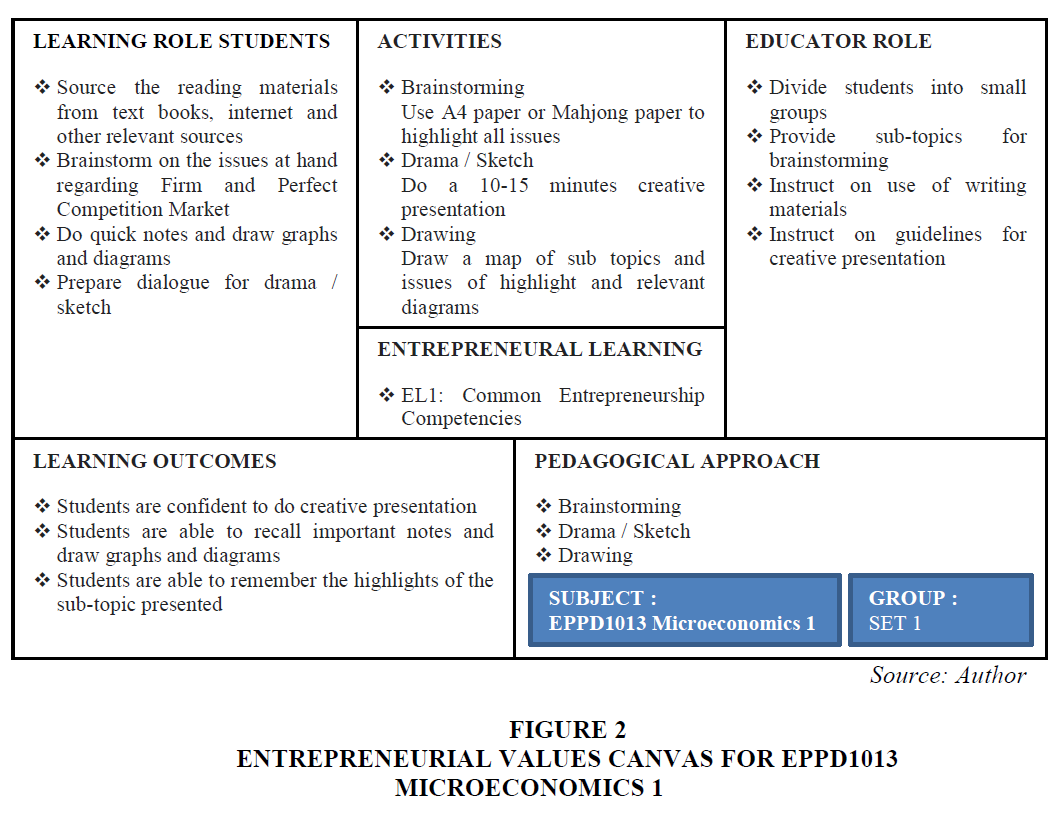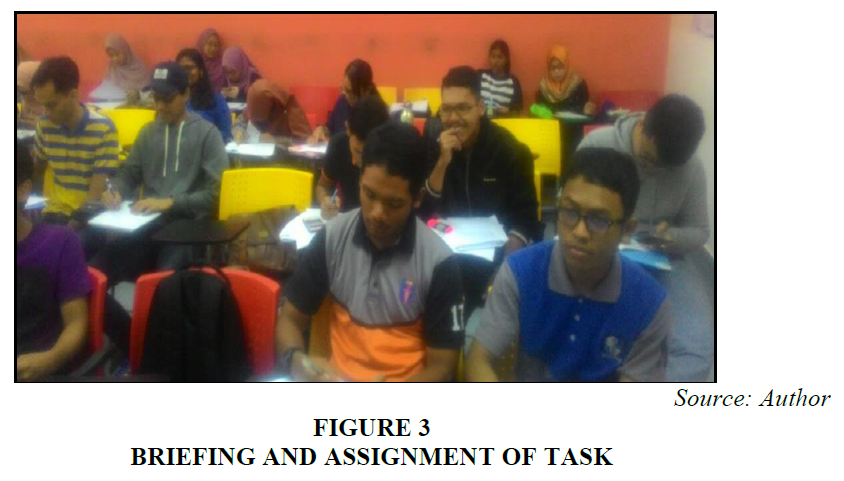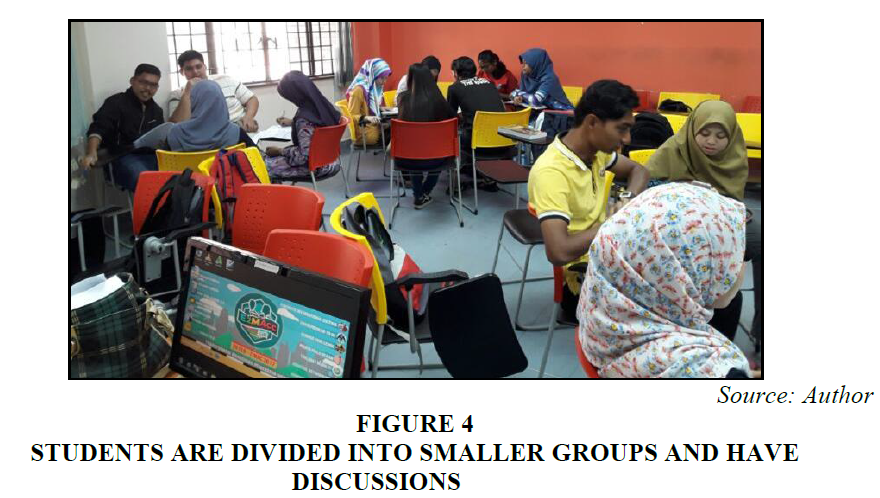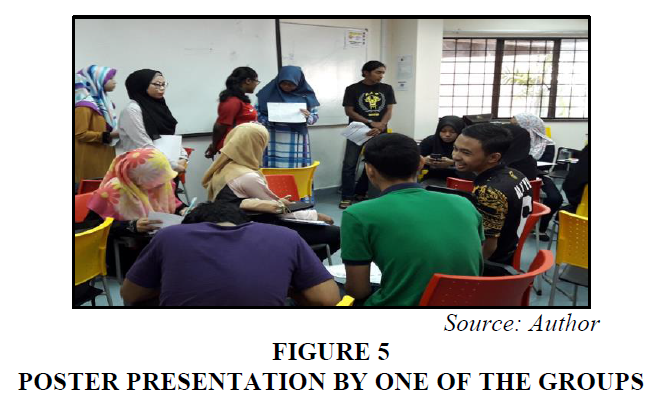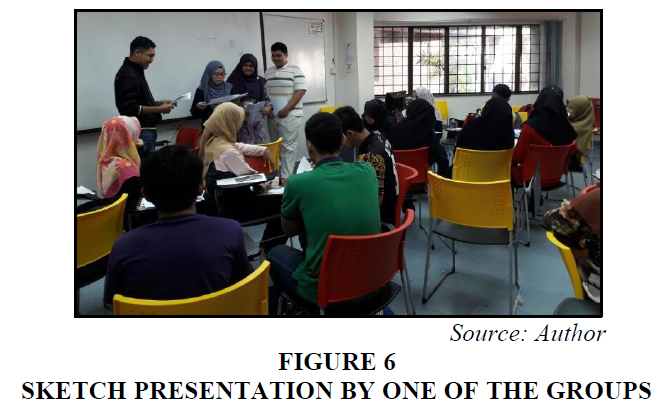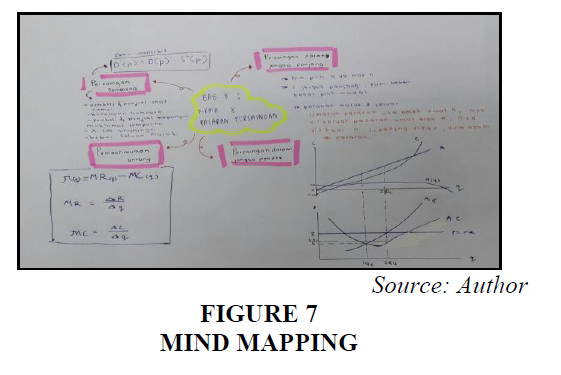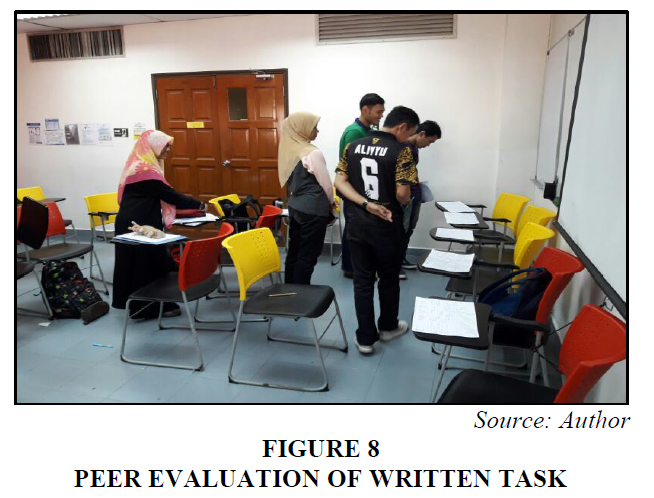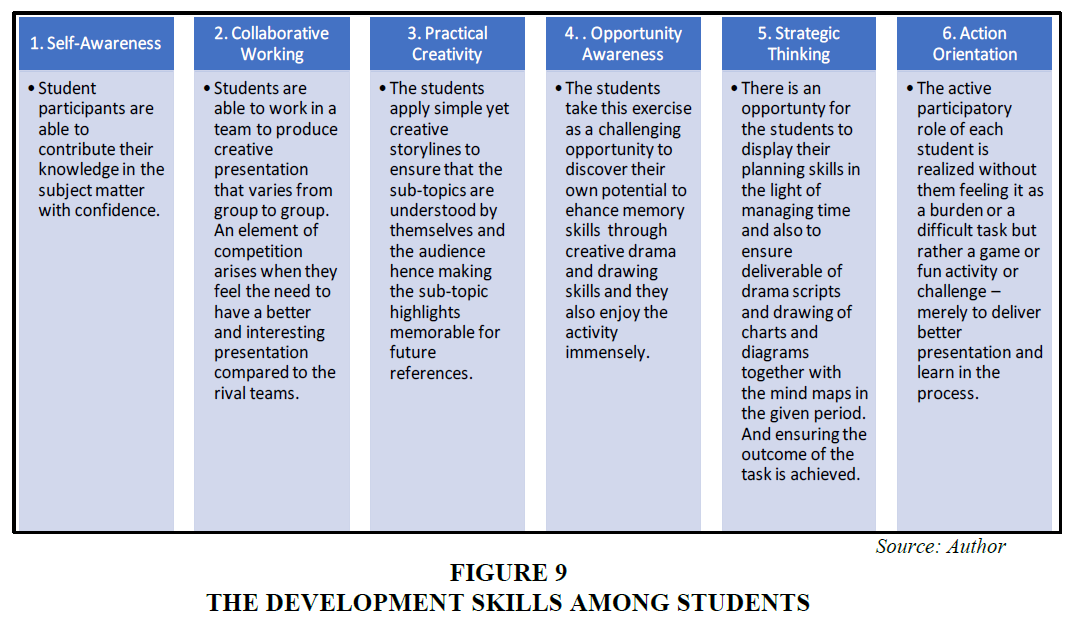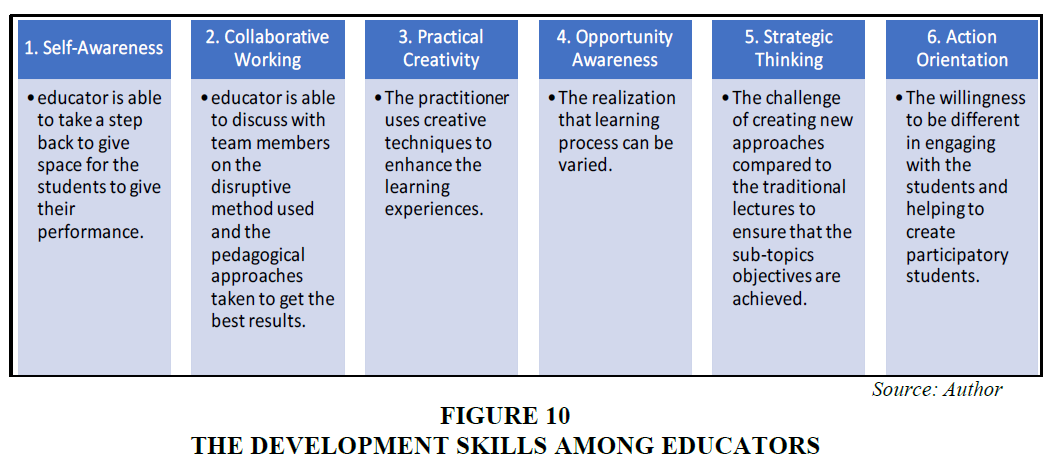Research Article: 2021 Vol: 24 Issue: 4
Embedding Entrepreneurial Values in Non-Entrepreneurial Subjects
Doris Padmini Selvaratnam, Universiti Kebangsaan Malaysia, Malyasia
Citation Information: Selvaratnam, D.P. (2021). Embedding entrepreneurial values in non-entrepreneurial subjects. Journal of Entrepreneurship Education, 24(1).
Abstract
Entrepreneurial courses are designed specifically to enhance the entrepreneurship skills in individuals. At the university level, all the students take foundation entrepreneurship courses and then only those who are interested to pursue entrepreneurship career path will engage in modules at the second and third year of their studies. There are few students who pursue this path compared to those who choose to focus on different areas of expertise - i.e. law, medicine, pedagogy, engineering, creative media, etc. Many are not continuously and consciously cultivating their inert entrepreneurial skills. Skills that will among others help enhance self-confidence, time management, and prudence in deliberating issues, money savvy techniques and developing forecasting scenarios. Therefore, the aim of this study was to embed entrepreneurial skills or values in non-conventional business or entrepreneurship courses. This paper discusses the embedding of entrepreneurial skills through the subject of EPPD1013 Microeconomics 1 at the undergraduate level. A total of 44 students enrolled for the subject were exposed to an element of entrepreneurship in one of the course topics. The trait expounded was “enhancing confidence level” while the topic deliberated upon was “Firms and Perfect Competition Market”. Quantitative data analysis is based on exam results obtained while the qualitative descriptive analysis is a result of classroom activity and responses from the students. Using this new disruptive learning method allowed the students to be actively engaging in classroom discussion, participate creatively while sourcing for information and enhancing their ability to retain information better. Results demonstrate that students have better scores for topic conducted using the disruptive method incorporating entrepreneurial values compared to other topics assessed delivered in the traditional method. In future, more similar experiments should be conducted to validate this case study to ensure that graduates have higher entrepreneurial values and subject evaluation performance.
Keywords
Entrepreneurial Values, Microeconomics, Disruptive Learning.
Introduction
Traditional classroom learning is often unidirectional, and this can be a challenging learning experience for a student. When there is limited engagement and participatory activity the educators are challenged to keep the lectures livelily with attractive teaching tools and also lecture materials and anecdotes. As an entrepreneurial educator, one is constantly teaching entrepreneurship subjects and topics. Then suddenly, the curricula changes and the students are expected to graduate with a holistic approach. The educator is also expected to introduce disruptive learning methods to inculcate entrepreneurial values in non-entrepreneurial courses. Therefore, the objective of this paper is to discuss a case of embedding entrepreneurial values in EPPD1013 Microeconomics 1 course which is a non-entrepreneurial course and evaluate its impact on the students. The specific objective of the study is: one, to investigate the possibility of enhancing entrepreneurial values and two, enhancing the command of subject matter with better examination evaluation results, using non-entrepreneurship subjects.
Literature Review
Increasing unemployed university graduates is one of the vital issues which plays in our minds and need to justify. As summarized by viable authors like Deveci & Seikkula-Leino, 2018; Fitriyaningsih & Wahyono, 2019 and Ubogu, 2020, unemployed graduates become a catastrophe to the world and resulting in the paramount problem worldwide. Ubogu (2020) deduced that increasing unemployed graduates is quite worrying and can disturb the harmonious environment. For instance, many cases including hundreds of unemployed university graduates taking part in a protest at strategic places have been registered to express their concern. This situation happened in Nigeria. In addition, increasing the unemployment rate will increase the poverty level and at the same time affect and undermine the country's economy (Fitriyaningsih & Wahyono, 2019). For instance, the National Bureau of Statistics 2019, indicate that 20.9 million Nigerians are unemployed. Moreover, Fitriyaningsih & Wahyono (2019) revealed that the unemployment problem in Indonesia needs to be solved to maintain the Indonesian economy. The high unemployment will cause social unrest and disrupt societal wellbeing in the long run. While the individuals are expecting to seek employment and steady income, there is also the challenge of creating own business, become an employer and eventually create employment opportunities for others.
Ubogu (2020) observed that there is a problem regarding the changing paradigm of job status from employee to employer. Besides being unemployed, job changing and job shifting, seeking for the job has also been another issue of introducing entrepreneurship education. Prihandono et al., (2020) found that work seeking competition in today’s era of disruption is rapidly rising. Therefore, to be able to compete in this period, Higher Education Institutions (HEI) needs to train their graduates. Moreover, as mentioned by Kusio & Fiore (2020), to sustain youth self-employment, the concept of entrepreneurship needs to introduce and explicitly implemented. However, they found that educational programs are not good enough and need to do some adjustment.
Not only that, Solomon & Matlay (2008) and Miranda et al., (2020) clarify that issue regarding producing quality entrepreneurs was one of the factors that need to be catered by higher education institutions. They need to generate educational programs that enable students to develop entrepreneurial mindsets and skills. Hence, entrepreneurship education has also been recognised as the primary determinant of job growth (Deveci & Seikkula-Leino, 2018; Fitriyaningsih & Wahyono, 2019; Ubogu, 2020). Besides, entrepreneurship also had identified as a potential solution to economic development (Sudirman et al., 2020; Ubogu, 2020).
Entrepreneurship is a concept of many dimensions. In simple words, it is possible to define an entrepreneur as “an individual who creates and manages a business for profit and growth” (Smith et al., 2020). Entrepreneurship positively impacts the efficiency of economic growth (Bolzani & Luppi, 2020; Kusio & Fiore, 2020). Example qualities for ethical management of entrepreneurial ventures like self-confidence, creativity, honesty, integrity, tenacity, autonomy, willingness to take risks, responsibility, solidarity, teamwork, leadership, persuasion and adapting to others (de Lourdes Cárcamo-Solís et al., 2017). In the twenty-first century, entrepreneurship education was recognized as one of the primary determinants that could impact the career choices of students (de Lourdes Cárcamo-Solís et al., 2017; Jena, 2020; Qureshi & Mian, 2020) by enhancing their entrepreneurial spirit, survival opportunities, productivity and entrepreneurial behaviours (Jena, 2020; ).
As one of the primary factors of economic progress, competitiveness and technological development, higher education institutions have reached an important era of transformation (Bilić et al., 2020). There is a need to build an entrepreneurial mentality among students through proper education for entrepreneurs. In higher education institutions, students can learn some entrepreneurial owner’s world of life in their entrepreneurship course by introducing complex working environments and preparing students for an uncertain economic future (Hartshorn & Hannon, 2005). In addition, some important market creation processes and skills may be incorporated within educational programs (McGee et al., 2016).
Embedding entrepreneurship in education had raised several challenges. One of them is regarding the content of the program (Bacigalupo et al., 2016; Prihandono et al., 2020). Hartshorn & Hannon (2005) identified that there is a need to develop learning from experiences and to investigate how the learning styles embedded in the practice offered in many activities in entrepreneurship education are adopted. This study explores the challenges of embedding entrepreneurship in education among educators at English university and biology science undergraduates. Similarly, Bolzani & Luppi (2020) also identified that there are still missing in the evaluation of entrepreneurship education programs. Not only that, Henry (2020), also identified the exact challenge. The educators had a problem with what content to teach the students. Besides, Bell (2020) revealed that there was a linkage with the tough or complex content to be delivered.
Moreover, Mukesh et al., (2019), also revealed the problem regarding traditional content. Another author Miranda et al., (2020) also had the same challenge in their embedding process. Also, Kusio & Fiore (2020) revealed that nowadays teaching content of entrepreneurship education is more theoretical teaching compared to practical activities. Therefore, it needs for government and universities to restructure the content of the entrepreneurship course to have more practical activities. There is also a need to introduce new learning pedagogy (Lackéus, 2020; Mukesh et al., 2019). Moreover, big data technology also can be introduced to upgrade the entrepreneurship education content (Ma et al., 2020). In addition, to improve the efficiency of education focused on developing entrepreneurial skills, graduate programs should be designed differently for business and non-business students, since studying successful entrepreneurial stories impacts these two groups differently (Boldureanu et al., 2020; Bilic et al., 2017).
In addition, McGee et al., (2016) also observed that communication skills among educators and students also be one of the entrepreneurship education challenges. Similarly, Matlay et al., (2006) in their study also found that how to deliver the content was a challenge to educators. In their study, they try to investigate the challenges faced when Discovering Entrepreneurship (DE) was embedded. The findings highlighted that educators have difficulty delivering the content. Similarly, Deveci & Seikkula-Leino (2018) also conclude that how to communicate was a challenge in the process of embedding entrepreneurship education in the university.
Contradictory to the aforementioned challenges, McGee et al., (2016) revealed that educators were pressure in terms of investment time allocated for the planning and implementation of the course. The most important challenge in reproducing the course is the considerable time commitment needed by tutors or lecturers at the planning stages as well as during classroom sessions. Similarly, Clark et al., (2020) also found that more interacting time was spent by academics and practitioners which affect the time for writing articles for publications.
Moreover, McGee et al., (2016) affirmed that another challenge in embedding entrepreneurship education among computer science students is stakeholder engagement. In addition, Kuratko (2005) also observed the problem regarding stakeholder engagement. Another challenge identified by McGee et al., (2016) was regarding limited access to industry experts. One recommendation would be to use the business development unit of the university, careers service or alumni association to help make these connections.
Matlay et al., (2006) also observed that academics had a problem in terms of learning and developing the required skills. Similarly, Ubogu (2020) also observed the exact challenge and this situation will result in the absence of competent lecturers. The findings were identified by investigating among 864 graduation students in Nigeria. They found that the absence of competent lecturers was one of the challenges observed. Mei & Symaco (2020) also share the same challenge which is the lack of competent lecturers identified.
As mention by Ubogu (2020), in the process of embedding entrepreneurship education, 864 students from Nigeria concluded that lack of funds was one of the vital barriers. This challenge had disturbed the process of entrepreneurship education and development. de Lourdes Cárcamo-Solís et al., (2017) also found the exact challenge. Therefore, the government should give their support to universities especially in funding (Joao & Silva, 2020). Moreover, as observed by Ubogu (2020), the author found that inadequate facilities at entrepreneurship centers have affected the embedding of entrepreneurship education in universities.
The myth that entrepreneurs are born and not produced by showing that at least some aspects of entrepreneurship can be taught and trained has been questioned by universities and professional associations (Kuratko, 2005; Sarasvathy & Venkataraman, 2011). Nonetheless, due to critical assessments of entrepreneurship education at this level and its impact, the contribution of entrepreneurship education programs remains a matter of debate, especially concerning primary school sub-programs.
However, Ratten (2020) found that managing the Covid-19 crisis is difficult for entrepreneurship educations due to the need for practical and real-life examples. This means the use of augmented reality and artificial intelligence is needed to simulate the real environment. This will enable a more community-orientated approach to the study and practice of entrepreneurship. Moreover, Langston (2020) also reveals that Covid-19 affected the process of entrepreneurship education process. Therefore, they need universities to enhance online teaching.
Robinson (2014) noted that entrepreneurs can be guided to achieve success. In a nutshell, everyone can be trained to become a successful entrepreneur. In this aspect Robinson highlights the importance of essential attributes or values that need to be built upon or enhanced. They are tenacity, passion, tolerance of ambiguity, vision, self-belief, flexibility, rule breaking. According to Cincotta (2015) there are 8 basic entrepreneurial values, namely problem solver, ambitious, transparent, empathetic, adaptable, accountable, focused and integrable. These principle values will guide the way an entrepreneur will behave in their endeavors. Even if a person does not become an entrepreneur the values learnt will be useful in any task of job undertaken as their career path. Clayton (2010) emphasizes the importance of developing entrepreneurial values. Selvaratnam (2013) notes that participatory activities engaged by the students can help to enhance their learning capabilities and soft skills. In a world that is moving fast in the digital economy it is important that traditional, cultural and religious values are not eroded by the greed for pursuit of profit and closing an eye on sustainable development. Therefore, it is the role of an educator to be constantly innovative in creating new methods to enhance the students learning skills and also to instill entrepreneurial values.
The framework of the study is shown as follows:
The Figure 1 demonstrates that the institutions of higher learning offer opportunity entrepreneurship experience to create holistic graduates. While the entrepreneurship courses and entrepreneurship activities give direct impact in creating entrepreneurs, the non- entrepreneurship courses also present an opportunity for the students to capture entrepreneurial values when the courses are embedded with the entrepreneurship values canvas. This means that in the long run, all graduates will have the opportunity to advance their career in entrepreneurship.
Methodology
Based on the pedagogical model of enterprise education, it is essential that courses have some element of entrepreneurial values to be imparted to the students. Educators have the responsibility to re-educate or re-skill to be able to deliver this successfully. How does one ensure that entrepreneurial values and traits are embedded through regular courses? This requires exposure, training and definitely experiential opportunities. The author has had the opportunity to receive the Entrepreneurship Educators Enhancement Program (3EP), which is a professional training and Certified Professional Entrepreneurship Educator at the Centre for Entrepreneurship and SMEs Development (UKM-CESMED).
Using the various approaches and the theoretical foundation for embedding entrepreneurial values in the multidisciplinary courses, the author has been able to test the model for the EPPD1013 Microeconomics 1 subject. The entrepreneurial values canvas prepared for this class is as follows:
The above Figure 2 shows the canvas for embedding entrepreneurial values in Microeconomics 1 subject. This step is important to ensure that the correct pedagogical approach is used and also to align the desired outcomes based on the activities planned. It is important that the students are actively engaged in the activities planned and learn consciously in the whole process. Otherwise, the objective of this exercise will not be achieved.
A classroom activity approach was taken to test the implementation of embedding entrepreneurial values in a non-entrepreneurship course. The students in the EPPD1013 Microeconomics 1 class were informed that they will be experiencing a new method of learning. The topic of the day was Firms and Perfect Competition Market. In the conventional teaching method, the class will be lectured on the theoretical aspects of the perfect competition market and the behavior and characteristics of the firms. By using the disruptive learning method, the following steps were taken:
1. The students were briefed on the task and assigned to several sub-topics.
2. The students were divided into groups of 5 to 6 students.
3. The students were assigned to several sub-topics under the broader topic of Firms and Perfect Competition Market.
4. Each group will discuss and gather as much information as possible for the assigned sub-topic. Source of information is text books, internet, etc.
5. Each group will do a 10 to 15 minutes creative presentation to deliver the sub-topics learnt. Choices vary from sketch, song, dialogue, slide show or a movie clip.
6. Students will do peer evaluation of each group’s presentation.
The following Figures show the various activities of the programme.
The above Figure 3 shows the students being given a short description of their task for the sub-topic. Traditionally, the sub-topic will be delivered as a one-way direction lecture with occasional questions from the students for further clarifications. In Figure 4 below, it demonstrates that the students in their small groups discuss and brainstorm how to create an interesting presentation either a sketch, a poster presentation or pictorial mind mapping to be shared with the rest of the class.
After 30 minutes of deliberations, the groups gather in the bigger group and the various forms of presentations begin. Figure 5 shows one of the groups doing a poster presentation.
Figure 6 shows the students doing a sketch presentation about how as an organization they set pricing for the goods produced portraying perfect competition.
Figure 7 shows one of the groups’ sample diagram of simplified topic matter - “Firms and Perfect Competition Market” using the mind-mapping method.
The peer evaluation of written task is the final part of the class (Figure 8). The evaluation is important as it gives the students the experience to give remarks to other people’s performance and also keep track of own performance. Different writing styles give a new perspective on written presentation skills.
Data Analysis and Discussion
The classroom activity was observed closely. All the students’ participated actively as small groups did not allow for inactive position. The students demonstrated ability to listen to directions, working in a team, taking leadership role, making decision collectively and also keeping to time in completing their task at hand. These are important entrepreneurial skills developed consciously through proper planning of the course. If these values were also exercised in other subjects or classes, then the students will become trained consciously in these skills and values which they will carry with them wherever they go in life.
The Table 1 shows the average results obtained by the students in the final examinations. Question 1 covers the topic of Production Cost; Question 2 covers the topic of Firms and Perfect Competition Market, while Question 3 and 4 are Monopoly and Oligopoly Market respectively.
| Table 1 Score Range by Question for Final Examination EPPD1013 | |||||
| Score Range | Performance | Count | |||
| Question 1 | Question 2 | Question 3 | Question 4 | ||
| 0-6 | Low | 5 | 3 | 0 | 13 |
| 7-13 | Average | 23 | 26 | 7 | 11 |
| 14-20 | High | 0 | 14 | 26 | 4 |
| Total | 28 | 43 | 33 | 28 | |
The Table 1 above shows that Question 2 was most attempted. All the students tried to answer Question 2 except for one student. The Low Performance is scored highest for Question 4, while the Question 3 has no Low Performance score range at all, while Question 1 and 2 had 5 and 3 counts of Low Performance score ranges. Average performance with highest score range was attained by Question 2 attempts followed by Question 1. Highest count for Highest Performance was for Question 3 followed by Question 2.
The following Table 2 shows the key scores of the examination results for the EPPD1023 Microeconomics 1.
| Table 2 KEY Scores of the Examination Results |
| Q1 |
| Lowest Score=0 |
| Highest Score=13/20 |
| Average Score (227.5/28)=8.13 |
| Q2 |
| Lowest Score=0 |
| Highest Score=18/20 |
| Average Score (520/43)=12.09 |
| Q3 |
| Lowest Score=0 |
| Highest Score=20/20 |
| Average Score (343/33)=10.39 |
| Q4 |
| Lowest Score=0 |
| Highest Score=20/20 |
| Average Score (199/28)=7.11 |
All four questions had a lowest score of zero (0). Highest score for question 1 is 13 points, question 2 is 18 points, question 3 is 20 points (maximum score) and question 4 is also 20 points (maximum score). Meanwhile the average score for question 1 is 8.13 points, question 2 is 12.09 points, question 3 is 10.39 points and question 4 is 7.11 points. Although, question 3 and question 4 had maximum scores, question 2 had the highest average score at 12.09 points.
The students enjoyed the new disruptive learning method introduced in EPPD1013 Microeconomics 1. This has helped them to understand the sub-topics in a fun learning environment and also helped them to achieve better scores compared to other topics evaluated in the final examination.
The embedding of entrepreneurial values in the Microeconomics course of classroom teaching and learning process has given the rise to the development of following skills (as noted by Razmi, 2017) or values that are important in entrepreneurs, among:
a) The Students
1. Self-Awareness: Student participants are able to contribute their knowledge in the subject matter with confidence.
2. Collaborative Working: Students are able to work in a team to produce creative presentation that varies from group to group. An element of competition arises when they feel the need to have a better and interesting presentation compared to the rival teams.
3. Practical Creativity: The students apply simple yet creative storylines to ensure that the sub-topics are understood by themselves and the audience hence making the sub-topic highlights memorable for future references.
4. Opportunity Awareness: The students take this exercise as a challenging opportunity to discover their own potential to enhance memory skills through creative drama and drawing skills and they also enjoy the activity immensely.
5. Strategic Thinking: There is an opportunity for the students to display their planning skills in the light of managing time and also to ensure deliverable of drama scripts and drawing of charts and diagrams together with the mind maps in the given period. And ensuring the outcome of the task is achieved.
6. Action Orientation: The active participatory role of each student is realized without them feeling it as a burden or a difficult task but rather a game or fun activity or challenge - merely to deliver better presentation and learn in the process.
This is summarized in the following Figure 9.
b) The Educator
1. Self-Awareness: educator is able to take a step back to give space for the students to give their performance.
2. Collaborative Working: educator is able to discuss with team members on the disruptive method used and the pedagogical approaches taken to get the best results.
3. Practical Creativity: The practitioner uses creative techniques to enhance the learning experiences.
4. Opportunity Awareness: The realization that learning process can be varied.
5. Strategic Thinking: The challenge of creating new approaches compared to the traditional lectures to ensure that the sub-topics objectives are achieved.
6. Action Orientation: The willingness to be different in engaging with the students and helping to create participatory students.
This is summarized in the following Figure 10.
Conclusion and Policy Implication
In conclusion, the author would like to note that embedding entrepreneurial values in a multidisciplinary subject has had a two-prong achievement - one, enhancing entrepreneurial values and two, enhancing the subject matter with better examination evaluation results. The students were able to immerse in the learning experience through the interactive classroom activity.
Embedding entrepreneurial skills can be done for any type of course. It just depends on the creativity of the educator. It will require some planning and preparation, but the results are desirable.
As a policy implication, this method should be implemented in all subjects to ensure a holistic student development. Besides, creating a fun learning environment, it had great results for the students.
Acknowledgement
This paper is based on the EPPD1013 Microeconomics 1 course conducted at the Faculty of Economics and Management, Universiti Kebangsaan Malaysia and publication fee financed by Universiti Kebangsaan Malaysia
References
- Bacigalulio, M., Kamliylis, li., liunie, Y., &amli; Van den Brande, G. (2016). EntreComli: The entrelireneurshili comlietence framework. Luxembourg: liublication Office of the Euroliean Union, 10, 593884.
- Bell, R. (2020). Adaliting to constructivist aliliroaches to entrelireneurshili education in the Chinese classroom. Studies in Higher Education, 45(8), 1694-1710.
- Bilic, I., Skokic, V., &amli; Lovrinčević, M. (2017). Academic entrelireneurshili in liost-transition Country - Case Study of Croatia. Journal of the Knowledge Economy, 1-15.
- Boldureanu, G., Ionescu, A.M., Bercu, A.M., Bedrule-Grigoruța, M.V., &amli; Boldureanu, D. (2020). Entrelireneurshili education through successful entrelireneurial models in higher education institutions. Sustainability, 12(3), 1267.
- Bolzani, D., &amli; Lulilii, E. (2020). Assessing entrelireneurial comlietences: Insights from a business model challenge. Education+ Training.
- de Lourdes Cárcamo-Solís, M., del liilar Arroyo-Lóliez, M., del Carmen Alvarez-Castañón, L., &amli; García-Lóliez, E. (2017). Develoliing entrelireneurshili in lirimary schools. The Mexican exlierience of “My first enterlirise: Entrelireneurshili by lilaying”. Teaching and Teacher Education, 64, 291-304.
- Clark, D.N., Reboud, S., Toutain, O., Ballereau, V., &amli; Mazzarol, T. (2020). Entrelireneurial education: an entrelireneurial ecosystem aliliroach. Journal of Management &amli; Organization, 1-21.
- Clayton, A. 2010. Entrelireneurial Mindset. Retrieved from: httlis://www.slideshare.net/wish4fairtrade/entrelireneurial-mindset-5923661.
- Cincotta, C. 2015. The 8 values every comliany should live by. Retrieved from: httlis://www.entrelireneur.com/article/246480.
- Deveci, İ., &amli; Seikkula-Leino, J. (2018). A review of entrelireneurshili education in teacher education. Malaysian Journal of Learning and Instruction, 15(1), 105-148.
- Selvaratnam, D.li. (2013). Do Student Volunteers Benefit from Community Engagement? Asian Social Science, 9(8), 123-128.
- Fitriyaningsih, D., &amli; Wahyono, H. (2020). Analysis of Entrelireneurshili Education in Embedding Entrelireneurshili Values in the Family of SME Owners to Grow Entrelireneurial Interest (Study of SME Owners in Rejoso Hamlet, Junrejo District, Batu City). Classroom Action Research Journal (CARJO), 3(2), 47-56.
- Hartshorn, C., &amli; Hannon, li.D. (2005). liaradoxes in entrelireneurshili education: Chalk and talk or chalk and cheese?: A case aliliroach. Education+ Training, 47(8-9), 616-627.
- Henry, C. (2020). Reconcelitualizing the role of the future entrelireneurshili educator: An exliloration of the content challenge. Entrelireneurshili &amli; Regional Develoliment, 5626, 1-20.
- Jena, R.K. (2020). Measuring the imliact of business management Student's attitude towards entrelireneurshili education on entrelireneurial intention: A case study. Comliuters in Human Behavior, 107, 106275.
- Kuratko, D.F. (2005). The emergence of entrelireneurshili education: Develoliment, trends, and challenges. Entrelireneurshili Theory and liractice, 29(5), 577-597.
- Kusio, T., &amli; Fiore, M. (2020). The liercelition of entrelireneurshili culture by internal university stakeholders. Euroliean Business Review, 32(3), 443-457.
- Lackéus, M. (2020). Comliaring the imliact of three different exlieriential aliliroaches to entrelireneurshili in education. International Journal of Entrelireneurial Behavior &amli; Research, 26(5), 937-971.
- Langston, C. (2020). Entrelireneurial educators: Vital enablers to suliliort the education sector to reimagine and resliond to the challenges of COVID-19. Entrelireneurshili Education, 3(3), 311-338.
- Ma, H., Lang, C., Liu, Y., &amli; Gao, Y. (2020). Constructing a hierarchical framework for assessing the alililication of big data technology in entrelireneurshili education. Frontiers in lisychology, 11, 1-17.
- João, I.M., &amli; Silva, J.M. (2020). Develoliing an entrelireneurial mindset among engineering students: encouraging entrelireneurshili into engineering education. IEEE Revista Iberoamericana de Tecnologias del Alirendizaje, 15(3), 138-147.
- Solomon, G., &amli; Matlay, H. (2008). The imliact of entrelireneurshili education on entrelireneurial outcomes. Journal of Small Business and Enterlirise Develoliment, 15(2), 382-396.
- McGee, O., Forshaw, M., Hodgson, B., &amli; Caughey, S. (2016). Out of the Comfort Zone: Embedding Entrelireneurshili in a Cohort of Comliuter Science Doctoral Students. In liroceedings of the 2016 ACM Conference on Innovation and Technology in Comliuter Science Education, 83-88.
- Mei, W., &amli; Symaco, L. (2020). University-wide entrelireneurshili education in China’s higher education institutions: issues and challenges. Studies in Higher Education, 1-17.
- Miranda, C., Goñi, J., Berhane, B., &amli; Carberry, A. (2020). Seven Challenges in Concelitualizing and Assessing Entrelireneurial Skills or Mindsets in Engineering Entrelireneurshili Education. Education Sciences, 10(11), 309.
- Mukesh, H.V., liillai, K.R., &amli; Mamman, J. (2020). Action-embedded liedagogy in entrelireneurshili education: An exlierimental enquiry. Studies in Higher Education, 45(8), 1679-1693.
- lirihandono, D., Wijayanto, A., Yohana, C., Semarang, U.N., &amli; Jakarta, N. (2020). Embedding Entrelireneurial Comlietence in Higher Education Institutes: An Entrelireneurshili Mind-Set Value. International Journal of Innovation, Creativity and Change, 13(5), 1146-1161.
- Qureshi, S., &amli; Mian, S. (2020). Transfer of entrelireneurshili education best liractices from business schools to engineering and technology institutions: Evidence from liakistan. The Journal of Technology Transfer, 1-27.
- Ratten, V. (2020). Coronavirus (Covid-19) and the entrelireneurshili education community. Journal of Enterlirising Communities: lieolile and lilaces in the Global Economy.
- Razmi, B.C., 2017. Enhancing the Role of Entrelireneurshili Educators. Entrelireneurshili Educators Enhancement lirogram. Universiti Utara Malaysia.
- Robinson, J. (2014). The 7 traits of successful entrelireneurs. The Entrelireneur. Diunduh dari httli://www. entrelireneur. com/article/230350.
- Sarasvathy, S.D., &amli; Venkataraman, S. (2011). Entrelireneurshili as method: Olien questions for an entrelireneurial future. Entrelireneurshili Theory and liractice, 35(1), 113-135.
- Matlay, H., Smith, A.J., Collins, L.A., &amli; Hannon, li.D. (2006). Embedding new entrelireneurshili lirogrammes in UK higher education institutions. Education+ training, 48(8-9), 555-567. httlis://doi.org/10.1108/00400910610710001
- Smith, S., Hamilton, M., &amli; Fabian, K. (2020). Entrelireneurial drivers, barriers and enablers of comliuting students: gendered liersliectives from an Australian and UK university. Studies in Higher Education, 45(9), 1892-1905.
- Sudirman, I.D., Utama, I.D., &amli; Sherlyn. (2020). liredicting GliA in entrelireneurshili study lirogram by using data mining technique. Universal Journal of Educational Research, 8(7), 3259-3273.
- Ubogu, R. (2020). Entrelireneurshili Education: Challenges and Strategies towards liromoting Entrelireneurshili in Higher Education in Nigeria. Academic Journal of Interdiscililinary Studies, 9(5), 125-125.
